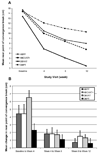Vision therapy/orthoptics for symptomatic convergence insufficiency in children: treatment kinetics
- PMID: 20543758
- PMCID: PMC2916019
- DOI: 10.1097/OPX.0b013e3181e61bad
Vision therapy/orthoptics for symptomatic convergence insufficiency in children: treatment kinetics
Abstract
Purpose: To evaluate the kinetics of change in symptoms and signs of convergence insufficiency (CI) during 12 weeks of treatment with commonly prescribed vision therapy/orthoptic treatment regimens.
Methods: In a randomized clinical trial, 221 children aged 9 to 17 years with symptomatic CI were assigned to home-based pencil push-ups (HBPP), home-based computer vergence/accommodative therapy and pencil push-ups (HBCVAT+), office-based vergence/accommodative therapy with home reinforcement (OBVAT), or office-based placebo therapy with home reinforcement (OBPT). Symptoms and signs were measured after 4, 8, and 12 weeks of treatment. The outcome measures were the mean CI Symptom Survey (CISS), near point of convergence (NPC), positive fusional vergence (PFV), and proportions of patients who were classified as successful or improved based on a composite measure of CISS, NPC, and PFV.
Results: Only the OBVAT group showed significant improvements in symptoms between each visit (p < 0.001). Between weeks 8 and 12, all groups showed a significant improvement in symptoms. Between-group differences were apparent by week 8 (p = 0.037) with the fewest symptoms in the OBVAT group. For each group, the greatest improvements in NPC and PFV were achieved during the first 4 weeks. Differences between groups became apparent by week 4 (p < 0.001), with the greatest improvements in NPC and PFV in the OBVAT group. Only the OBVAT group continued to show significant improvements in PFV at weeks 8 and 12. The percentage of patients classified as "successful" or "improved" based on our composite measure increased in all groups at each visit.
Conclusions: The rate of improvement is more rapid for clinical signs (NPC and PFV) than for symptoms in children undergoing treatment for CI. OBVAT results in a more rapid improvement in symptoms, NPC and PFV, and a greater percentage of patients reaching pre-determined criteria of success when compared with HBPP, HBCVAT+, or OBPT.
Trial registration: ClinicalTrials.gov NCT00338611.
Figures



References
-
- Sheard C. Zones of ocular comfort. Am J Optom. 1930;7:9–25.
-
- Borsting EJ, Rouse MW, Mitchell GL, Scheiman M, Cotter SA, Cooper J, Kulp MT, London R. Validity and reliability of the revised convergence insufficiency symptom survey in children aged 9 to 18 years. Optom Vis Sci. 2003;80:832–838. - PubMed
Publication types
MeSH terms
Associated data
Grants and funding
LinkOut - more resources
Full Text Sources
Medical

